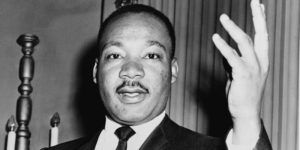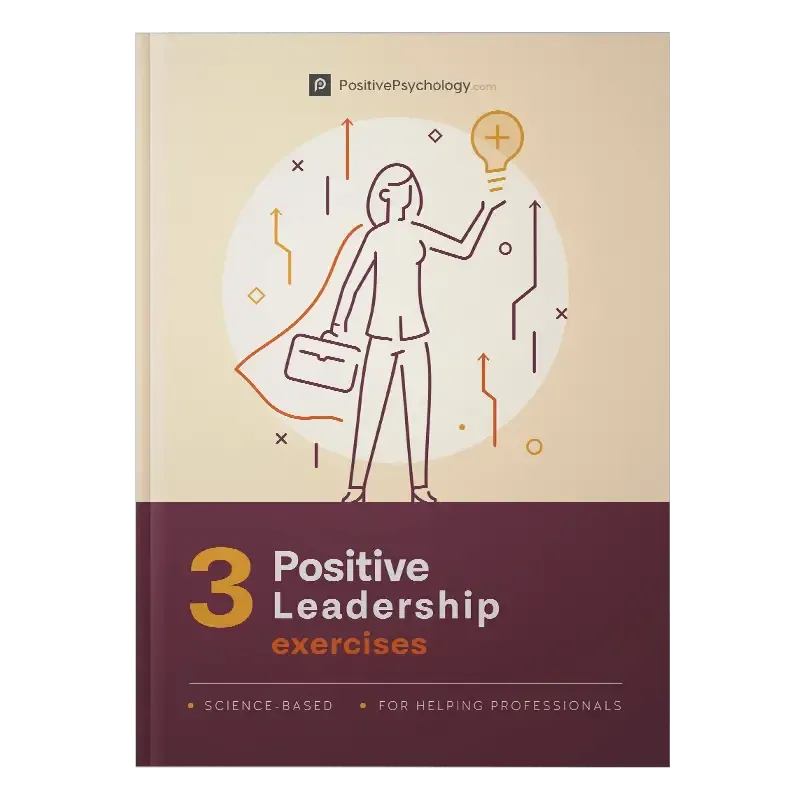Strength-Based Leadership: 34 Traits Of Successful Leaders
 Leaders throughout history have inspired, disappointed, empowered, enraged, challenged, and scared the people they serve.
Leaders throughout history have inspired, disappointed, empowered, enraged, challenged, and scared the people they serve.
They can lead nations through wars or squander their country’s finances while offering a figurehead for our hopes and dreams.
Think of Jacinda Ardern, Mahatma Gandhi, Margaret Thatcher, Malcolm X, Nelson Mandela, Angela Merkel, Donald Trump, Joseph Stalin, and Winston Churchill.
You may love or loathe them, but they are all leaders with unique sets of strengths and weaknesses.
In the past, psychology has found many ways to compare leadership styles: democratic versus autocratic, participative versus directive, and personalized versus positional. However, new insights have arrived from research into our distant past.
According to evolutionary psychologists, a more appropriate grouping of leadership styles might be “prestige” and “dominance.” Leaders in the former category are knowledgeable, wise, and formidable influencers, while the latter demand support and are often physically imposing (Young, 2020).
However we split leadership styles, decades of research have confirmed that the best leaders are not equally skilled in all aspects of leadership. Instead, they are excellent at utilizing their strengths while surrounding themselves with people who make up for their shortfalls.
In this article, we explore some of those strengths and their use in leadership.
Before you continue, we thought you might like to download our three Positive Leadership Exercises for free. These detailed, science-based exercises will help you or others adopt positive leadership practices and help organizations thrive.
This Article Contains:
What Is Strength-Based Leadership?
Twenty years ago, a team of experts at Gallup set about determining what makes an effective leader (Rath & Conchie, 2009).
The data they sifted through was extensive: 50 years of Gallup polls, 20,000 interviews with senior leaders and followers, and studies of more than a million teams from all over the world.
In their book, Strengths-Based Leadership, Tom Rath and Barry Conchie (2009) outlined key findings that emerged.
The most effective leaders:
- Invest in employees’ strengths
- Gather together the right people to ensure the best team
- Understand the needs of their followers
However, the most capable leaders are not well rounded, as we might expect, with an equally balanced set of strengths. Furthermore, each is unique, and of those interviewed, none were the same.
Their research provides crucial insights into leadership.
- No two leaders share the same strengths and weaknesses.
- Attempting to mimic the skills of another will offer only limited benefits.
- No leader can be good at everything; they should focus on using their strengths.
While great leaders may share similarities, they also exhibit many differences that define who they are as leaders and drive them to success.
Recognizing leadership strengths
Along with his colleagues, Don Clifton, often referred to as the father of strengths-based psychology, compared answers and performance across the 20,000 leaders interviewed.
No single strength was shared by all, or even the majority, of leaders. Instead, it became apparent that it is more important that leaders know their strengths and how and when to use them.
34 Strengths of Successful Leaders

Indeed, research confirms that ignoring your strengths, empowering weaknesses, and striving to be an excellent all-rounder is misguided (Niemiec & McGrath, 2019).
For example, a visionary leader may not be a great communicator, and someone extraordinary at sharing knowledge may lack deep insights into the future direction of the company. And yet, putting in place the best team with a balance of strengths (and listening to them) will offset the deficiencies.
As part of Gallup’s research into strengths, the team not only interviewed thousands of leaders – often at the CEO level – but also members of the hierarchy below (Rath & Conchie, 2009).
What they found was that the leaders’ strengths belong to one of the following four domains:
- Executing
Being able to make things happen and get jobs done, turning an idea into reality - Influencing
The ability to reach a wider audience and sell ideas beyond the confines of their organization - Relationship building
The ability to hold the team together, creating and maintaining unity, rather than existing as a collection of individuals - Strategic thinking
A company that plans to survive needs leaders with vision – the ability to see what could be.
They also recognized that a high-performing team should have individuals that represent each of the four domains.
“Although individuals [leaders] need not be rounded, teams should be” (Rath & Conchie, 2009).
34 themes were identified that fit within each of the four domains (modified from Rath & Conchie, 2009):
| Executing | Relationship building |
|---|---|
| Achiever | Adaptability |
| Arranger | Connectedness |
| Belief | Developer |
| Consistency | Empathy |
| Deliberative | Harmony |
| Discipline | Includer |
| Focus | Individualization |
| Responsibility | Positivity |
| Restorative | Relator |
| Influencing | Strategic thinking |
|---|---|
| Activator | Analytical |
| Command | Context |
| Communication | Futuristic |
| Competition | Ideation |
| Maximizer | Input |
| Self-assurance | Intellection |
| Significance | Learner |
| Woo (i.e., persuader) | Strategic |
Let’s look at a sample of the above themes and see how they underpin each domain.
Executing domain
The achiever works relentlessly towards a goal, while the arranger excels at identifying the ideal balance of people to achieve it.
Influencing domain
Someone with command or self-assurance is gifted in conveying a powerful message. Those with communication or woo place people in a position where they feel comfortable doing their best work.
Relationship building domain
Those who exhibit positivity and harmony focus on reducing distractions and interruptions to their team, allowing them to focus on the task at hand. At the same time, the relator or mentor is a passionate guide for the team to reach their true potential.
Strategic thinking domain
An individual strong in context or strategic themes takes lessons from the past to create a vision of the future. At the same time, the analytical leader looks at the data to understand the connection between cause and effect.
Remember, there is no ideal set of leadership strengths; each leader, and their balance of strengths, is unique.
4 Real-Life Examples

Executing – how to get things done
TV chef Jamie Oliver took a bold idea – to challenge the eating habits of an entire generation – and rolled it out to a nation of schoolchildren.
His healthy eating campaign began with 10,000 students in 27 schools, before securing an incredible £280 million in funding from then UK Prime Minister Tony Blair.
This is probably one of the most important and biggest food revolutions in this country ever.
Jamie Oliver
The journey continues, but so far, with Jamie’s leadership, junk food has been banned and improved food standards have been implemented in UK schools.
Despite evidence of improved pupils’ grades and lowered absenteeism, the journey is not over, and the fight continues to improve the eating habits of UK children.
Influencing, how to convey powerful messages
The ‘I have a dream’ speech is perhaps one of the greatest in American history.
On August 28, 1963, civil rights activist Martin Luther King Jr. gave a speech to over 250,000 people, calling for an end to racism in the United States.
His speech became a defining moment for the civil rights movement, impacting not only the generation at the time but those that followed.
I have a dream that my four children will one day live in a nation where they will not be judged by the color of their skin, but by the content of their character.
Martin Luther King Jr.
A year later, Martin Luther King Jr. was awarded the Nobel Peace Prize before tragically being shot in 1968.
Relationship building, how to build a team rather than a collection of individuals
Hillary Clinton may have failed in her attempt in 2016 to become US President, but in doing so, she inspired millions of girls and women around the world.
According to The New York Times, by losing the presidency, she set off a crusade that led to women’s marches, an increase in female candidates running for office, and widespread outcry regarding sexual assault (Chozick, 2018).
Clinton’s connection with women at a grassroots level led to a shared sense of strength and common goals, showing that even in defeat, she was able to be a strong leader.
Strategic thinking, how to make bold decisions for the future based on insights from the past
Brad Anderson, CEO of electronics retailer Best Buy, created a company atmosphere that is more like a college campus than a Fortune 500 company headquarters (Rath & Conchie, 2009).
Anderson’s insatiable curiosity led him to study the existing yet failing retail model. Using his deep understanding, he placed the needs of the customer first and challenged convention, which resulted in incredible growth.
Anderson may not look or act like a conventional CEO, but, in 25 years, he has taken a mostly unheard of store and turned it into the largest electronics retailer in America.
Finding Your Leadership Strengths: 3 Assessment Tools

While this article focuses on the Clifton model of strength-based leadership, there are others, including the Values in Action Inventory.
StrengthsFinder
Gallup’s leadership-specific StrengthsFinder (since named the CliftonStrengths in memory of Dan Clifton) is an online questionnaire that takes approximately 30 minutes to complete.
Once finished, it produces a set of reports based on your ranked themes, their domains, and a list of personalized insights.
For example, having completed the questionnaire, four out of five of my top themes are under the strategic thinking domain, while the other is under influencing.
Using the output from my questionnaire as an example, we can see some of the insights provided:
Learner
- You love to learn and have a desire to improve.
- You enjoy concentrating for extended periods and being inspired by your work.
- You tend to avoid situations that do not expand your mind.
Input
- You listen intently before contributing.
- You are driven to make discoveries that bring others joy.
- Your drive to learn and understand, along with your curiosity, is not easily satisfied.
Intellection
- You are introspective and enjoy intellectual discussions.
- You enjoy language, and learning sophisticated terminology, as a form of play.
- You read everything – books, journals, websites, etc.
Ideation
- You are fascinated by ideas and enjoy trying to find the connections between ones that seem unrelated.
- You sometimes lack effort when forced to perform a traditional process defined elsewhere.
Maximizer
- You set aside time to think about the future.
- You seek opportunities to use your strengths and others’.
- You have a calming effect on others, and your presence reassures them.
- You are happier when you practice your strength-based skills every day.
For each ranked theme, you are asked to consider:
- What words and phrases stand out?
- What talents would you like others to see in you most of all?
While we have focused mainly on the Clifton model due to its dominance in the field, there are other approaches to understanding personal strengths.
Values in Action Inventory
Building on the research by Clifton, Christopher Peterson, and Martin Seligman (2004) explored and analyzed writings from around the world.
Their findings identified 24 character strengths, which they grouped under six virtues: justice, wisdom, courage, humanity, temperance, and transcendence.
The free Values in Action Inventory of Strengths survey provides crucial insights into who we are and our moral virtues.
Coaching
Being aware of and knowing how to use your strengths can be two different things.
Coaching is one of the most time-effective ways of developing leadership. A 2014 study found that when 37 executives and managers received workplace coaching over three months, their leadership skills improved significantly (Mackie, 2014).
Strength-based coaching offers a practical approach to finding our strengths and developing existing and future leaders.
Video review for strengths based leadership by Tom Rath and Barry Conchie – Callibrain
A Look at Leadership Weakness Traits
Perhaps the most significant leadership weakness not being aware of and using your strengths and character traits.
And this is not uncommon. Indeed, poor leadership can often be seen most clearly at the highest levels of government, where visibility is the greatest and failure has the most significant impact.
Unsurprisingly then, a 2014 survey of World Economic Forum members reported that world leaders were far from effective. Their poor results are possibly a result of the failure of the world to take adequate measures against global warming, a failing global economy, and instability in the Middle East (Shahid, n.d.).
For confidence to be restored, the world will need more than inspirational leaders. Leaders must also be able to listen to one another and their citizens and be better at working toward reconciliation rather than confrontation.
According to the findings of the report, good leadership requires optimism, delegation, team building, and the ability to deliver results.
10 Inspiring Quotes

If you can dream it, you can do it.
Walt Disney
My best successes came on the heels of failures.
Barbara Corcoran
We must believe that we are gifted for something, and that this thing, at whatever cost, must be attained.
Marie Curie
A leader takes people where they want to go. A great leader takes people where they don’t necessarily want to go, but ought to be.
Rosalynn Carter
Coming together is a beginning. Keeping together is progress. Working together is success.
Henry Ford
A leader’s role is to raise people’s aspirations for what they can become and to release their energies so that they will try to get there.
David Gergen
The question isn’t who’s going to let me; it’s who is going to stop me.
Ayn Rand
A leader is like a shepherd. He stays behind the flock, letting the most nimble go out ahead, whereupon the others follow, not realizing that all along they are being directed from behind.
Nelson Mandela
We’re here to put a dent in the universe. Otherwise why else even be here?
Steve Jobs
The only way to make sense out of change is to plunge into it, move with it, and join the dance.
Alan Watts
10 Books on the Topic
Whether you are interested in becoming a better leader or understanding and using your strengths, the following books provide some valuable insights.
- Strengths-Based Leadership: Great Leaders, Teams, and Why People Follow – Tom Rath and Barry Conchie (Amazon)
- The Strengths Book: Discover How to be Fulfilled in Your Work and in Life – Sally Bibb (Amazon)
- The Power of Character Strengths: Appreciate and Ignite Your Positive Personality – Ryan Niemiec and Robert McGrath (Amazon)
- Character Strengths Interventions: A Field Guide for Practitioners – Ryan Niemiec (Amazon)
- Character Strengths Matter: How to Live a Full Life – Shannon Polly and Kathryn Britton (Amazon)
- A Practical Guide to Leadership: Be Inspired by Great Leaders – Alison Price and David Price (Amazon)
- It’s the Manager: Moving from Boss to Coach – Jim Clifton and Jim Harter (Amazon)
- The Inspirational Leader: Inspire Your Team to Believe in the Impossible – Gifford Thomas (Amazon)
- Learning to Lead: The Journey to Leading Yourself, Leading Others, and Leading an Organization – Ron Williams and Karl Weber (Amazon)
- Shackleton’s Way: Leadership Lessons From the Great Antarctic Explorer – Margot Morrell, Stephanie Capparell, and Alexandra Shackleton (Amazon)
PositivePsychology.com Resources
Our Maximizing Strengths Masterclass© provides a comprehensive six-module science-based package for practitioners that contains all the materials you’ll need to help your clients identify their unique potential, feel more energized and authentic, and perform at an optimal level.
The Positive Psychology Toolkit© has over 400 exercises and interventions to discover and develop your own or clients’ strengths to promote optimal functioning.
Cultivating Your Strengths at Work is a related blog post with useful insights and worksheets.
If you’re looking for more science-based ways to help others develop their strengths, this collection contains 17 strength-finding tools for practitioners. Use them to help others better understand and harness their strengths in life-enhancing ways.
A Take-Home Message
At some point in our lives, we are all likely to lead, but it doesn’t mean we enjoy it or are any good at it.
Nevertheless, both leading and following are natural, based on evolved strategies that allow us to tackle problems that can only be solved by working as a team (Buss, 2016).
And good or, more likely, great leadership provides a tremendous opportunity for large-scale change. If we are to tackle the most significant challenges humanity faces – including climate change, world hunger, pollution, and clean energy – people need to work together toward a common good.
But a great leader must not be mediocre, equally competent at everything; instead, they should be exceptional in their strengths.
Knowing, understanding, developing, and using our leadership strengths is crucial to becoming our best selves and making the changes we require as individuals, nations, and a global community.
We hope you enjoyed reading this article. Don’t forget to download our three Positive Leadership Exercises for free.
- Bibb, S. (2017). The strengths book: Discover how to be fulfilled in your work and life. LID Publishing.
- Buss, D. M. (2016). Evolutionary psychology: The new science of the mind. Routledge, Taylor & Francis Group.
- Chozick, A. (2018, January 13). Hillary Clinton ignited a feminist movement. By losing. The New York Times. Retrieved July 15, 2020, from https://www.nytimes.com/2018/01/13/sunday-review/hillary-clinton-feminist-movement.html
- Clifton J., & Harter, J. (2019). It’s the manager: Moving from boss to coach. Gallup Press.
- I Have a Dream. (2020, July 11). Retrieved July 15, 2020, from https://en.wikipedia.org/wiki/I_Have_a_Dream
- Mackie, D. (2014). The effectiveness of strength-based executive coaching in enhancing full range leadership development: A controlled study. Consulting Psychology Journal: Practice and Research, 66(2), 118–137.
- Morrell, M., Capparell, S., & Shackleton, A. (2002). Shackleton’s way: Leadership lessons from the great Antarctic explorer. Penguin Books.
- Niemiec, R. M. (2017). Character strengths interventions: A field guide for practitioners. Hogrefe.
- Niemiec, R. M., & McGrath, R. E. (2019). The power of character strengths: Appreciate and ignite your positive personality. VIA Institute on Character.
- Peterson, C., & Seligman, M. E. P. (2004). Character strengths and virtues: A handbook and classification. Oxford University Press.
- Polly, S. & Britton, K. (2015). Character strengths matter: How to life a full life. Positive Psychology News.
- Price, A., & Price, D. (2018). A practical guide to leadership: Be inspired by great leaders. Icon Books.
- Rath, T., & Conchie, B. (2009). Strengths-based leadership: Great leaders, teams, and why people follow. Gallup Press.
- Shahid, S. (n.d.). Lack of leadership. World Economic Forum. Retrieved July 15, 2020, from http://reports.weforum.org/outlook-global-agenda-2015/top-10-trends-of-2015/3-lack-of-leadership/
- Thomas, G. (2019). The inspirational leader: Inspire your team to believe in the impossible. Author.
- Williams, R., & Weber, K. (2019). Learning to lead: The journey to leading yourself, leading others, and leading an organization. Greenleaf Book Group Press.
- Young, E. (2020, July 1). Evolution tells us why there are two types of leaders in today’s world. New Scientist. Retrieved July 15, 2020, from https://www.newscientist.com/article/mg24632891-000-evolution-tells-us-why-there-are-two-types-of-leader-in-todays-world/
Read other articles by their category
- Body & Brain (42)
- Coaching & Application (54)
- Compassion (26)
- Counseling (50)
- Emotional Intelligence (24)
- Gratitude (18)
- Grief & Bereavement (21)
- Happiness & SWB (39)
- Meaning & Values (25)
- Meditation (20)
- Mindfulness (44)
- Motivation & Goals (43)
- Optimism & Mindset (32)
- Positive CBT (25)
- Positive Communication (20)
- Positive Education (44)
- Positive Emotions (30)
- Positive Leadership (13)
- Positive Psychology (32)
- Positive Workplace (33)
- Productivity (16)
- Relationships (41)
- Resilience & Coping (34)
- Self Awareness (20)
- Self Esteem (36)
- Software & Apps (13)
- Strengths & Virtues (30)
- Stress & Burnout Prevention (33)
- Theory & Books (44)
- Therapy Exercises (35)
- Types of Therapy (58)




